Related Research Articles
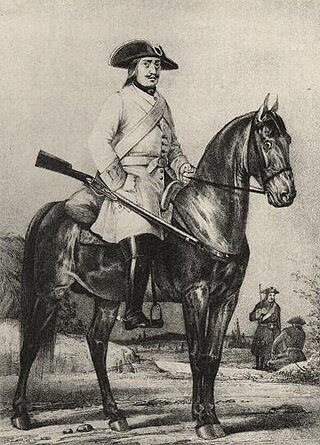
Dragoons were originally a class of mounted infantry, who used horses for mobility, but dismounted to fight on foot. From the early 17th century onward, dragoons were increasingly also employed as conventional cavalry and trained for combat with swords and firearms from horseback. While their use goes back to the late 16th century, dragoon regiments were established in most European armies during the 17th and early 18th centuries; they provided greater mobility than regular infantry but were far less expensive than cavalry.
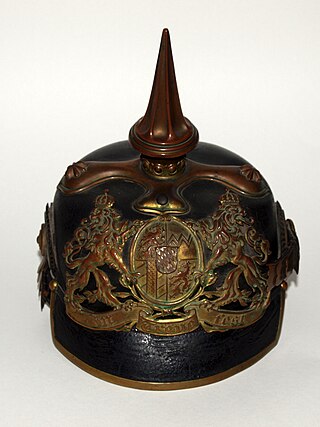
The Pickelhaube, also Pickelhelm, is a spiked leather or metal helmet that was worn in the 19th and 20th centuries by Prussian and German military officers, firefighters and police. Although it is typically associated with the Prussian Army, which adopted it in 1842–43, the helmet was widely imitated by other armies during that period. It is still worn today as part of ceremonial wear in the militaries of certain countries, such as Sweden, Chile, and Colombia.

Sir Banastre Tarleton, 1st Baronet was a British general and politician. He is best known as the lieutenant colonel leading the British Legion at the end of the American Revolution. He later served in Portugal and held commands in Ireland and England.

The British Legion was an elite British provincial regiment established during the American Revolutionary War, composed of Loyalist American troops, organized as infantry and cavalry, plus a detachment from the 16th Light Dragoons. The unit was commonly known as Tarleton's Legion, after the British officer who led it on campaign, Lieutenant Colonel Banastre Tarleton. It was a unit the size of a regiment, consisting of artillery, cavalry, and light infantry, and able to operate independently.
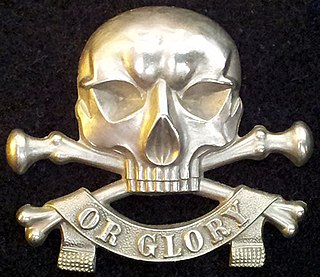
The 17th Lancers (Duke of Cambridge's Own) was a cavalry regiment of the British Army, raised in 1759 and notable for its participation in the Charge of the Light Brigade during the Crimean War. The regiment was amalgamated with the 21st Lancers to form the 17th/21st Lancers in 1922.

The Battle of Waxhaws was a military engagement which took place on May 29, 1780 during the American Revolutionary War between a Patriot force led by Abraham Buford and a British force led by Banastre Tarleton near Lancaster, South Carolina. Buford's men consisted of Continental Army soldiers, while Tarleton's force was mostly made up of Loyalist troops. After the two forces sighted each other, Buford rejected an initial demand to surrender. Tarleton's cavalrymen launched a charge against the Patriot troops, which led many of Buford's men to throw their arms down in surrender. However, as Tarleton was shot under his horse during the charge, his infuriated soldiers attacked their Patriot opponents, killing several.
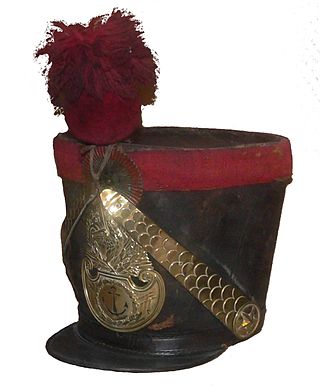
A shako is a tall, cylindrical military cap, usually with a visor, and sometimes tapered at the top. It is usually adorned with an ornamental plate or badge on the front, metallic or otherwise; and often has a feather, plume or pompom attached at the top.
The 4th Continental Light Dragoons, also known as Moylan's Horse, was raised on January 5, 1777, at Philadelphia, Pennsylvania, for service with the Continental Army under Colonel Stephen Moylan. The regiment was known for taking the field in captured British scarlet coats, as noted in a letter from George Washington to Colonel Moylan dated May 12, 1777, in which Moylan was directed to have his uniforms dyed to avoid confusion with British dragoons. The regiment changed to green coats faced in red during the summer of 1778, with Tarleton helmets.
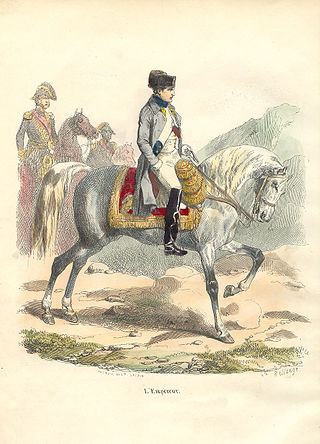
The uniforms of La Grande Armée, the army of Napoleon I, are described in this article.
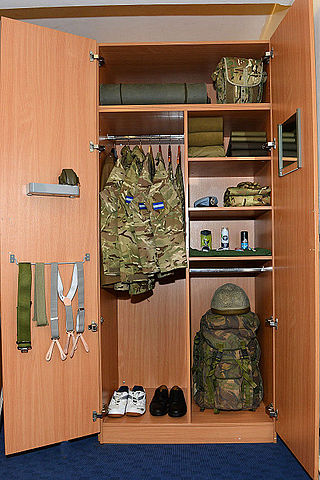
The uniforms of the British Army currently exist in twelve categories ranging from ceremonial uniforms to combat dress. Uniforms in the British Army are specific to the regiment to which a soldier belongs. Full dress presents the most differentiation between units, and there are fewer regimental distinctions between ceremonial dress, service dress, barrack dress and combat dress, though a level of regimental distinction runs throughout.
The Battle of Wetzell's Mill was an American Revolutionary War battle fought on March 6, 1781, between detachments of Nathanael Greene's Continental Army and militia and Banastre Tarleton's Loyalist provincial troops in Guilford County, North Carolina.

The North Somerset Yeomanry was a part-time cavalry regiment of the British Army from 1798 to 1967. It maintained order in Somerset in the days before organised police forces, and supplied volunteers to fight in the Second Boer War. It served on the Western Front in the First World War. At the outbreak of the Second World War, it continued to operate in the mounted role and then as a specialist signals unit. Postwar it joined the Royal Armoured Corps and later became infantry. Its lineage today is maintained by 93 Squadron 39 (Skinners) Signal Regiment.

The Queen's Own Yorkshire Dragoons was a yeomanry regiment of the British Army in existence from 1794 to 1956. It was formed as a volunteer cavalry force in 1794 during the French Revolutionary Wars. Its volunteer companies played an active role with the Imperial Yeomanry in the Second Boer War, but opportunities for mounted action were much more restricted during the First World War and it was temporarily converted into a cycle unit. It remained a cavalry regiment throughout the interwar years, and was the last horsed unit of the British Army to see action, in the Syria–Lebanon Campaign of 1941, finally mechanising the following year. It served as motorised infantry in the North African and Italian campaigns of the Second World War. In 1956, it merged with the Yorkshire Hussars and the East Riding of Yorkshire Yeomanry to form the Queen's Own Yorkshire Yeomanry. Its lineage is continued today by A Squadron, the Queen's Own Yeomanry.

The British Army during the Napoleonic Wars experienced a time of rapid change. At the beginning of the French Revolutionary Wars in 1793, the army was a small, awkwardly administered force of barely 40,000 men. By the end of the period, the numbers had vastly increased. At its peak, in 1813, the regular army contained over 250,000 men. The British infantry was "the only military force not to suffer a major reverse at the hands of Napoleonic France."

The modern Greek Army has a history of almost 200 years, during which it has undergone dramatic changes and been involved in some of the major conflicts on the European continent. The modern Greek military throughout its history was closely following international developments in equipment and uniforms. With the notable exception of the elite Evzones units, which based their uniforms on the indigenous traditional garments of the 18th century, the rest of the Army, as most militaries worldwide, was always quick to adopt the military fashion current among the armies of the influential Great Powers. This influence can be roughly divided in three periods: French-style uniforms, which dominated throughout the 19th century, the British styles introduced around World War I and used during World War II and until the late 1960s, and the "NATO" or US-style predominating from ca. 1968 onward. Various individual items or details can of course be traced to other influences, and there were also transitional uniforms combining previous designs.

A dragoon helmet was an ornate style of metal combat helmet featuring a tall crest; they were initially used by dragoons, but later by other types of heavy cavalry and some other military units. Originating in France in the second half of the 18th century, it was widely imitated by other European armies and was last used in combat in 1914. Some military units continue to wear this style of helmet for parades and other ceremonial duties.
Life Guards of Horse was a Swedish Army cavalry regiment, first raised in 1770. It saw service for two centuries, before being amalgamated with the Life Regiment Dragoons to form the Life Regiment of Horse in 1928.

Armour in the 18th century was minimalist and restricted almost entirely to cavalry, primarily to cuirassiers and, to a lesser degree, carabiniers and dragoons. Armour had been in rapid decline since the Thirty Years' War, although some archaisms had lingered on into the early years of the 18th century, like Austrian cuirassiers with buff coats and lobster-tailed helmets or Hungarian warriors with mail armour and shields. With the exception of Poland-Lithuania, which still made use of hussars wearing suits of plate armour, armour in Europe was primarily restricted to a breast- and backplate, the cuirass, and a simple iron skull cap worn under the hat. By the later 18th century, there were two contradicting developments. Many cuirassier regiments were discarding their cuirasses, while helmets in the form of so-called dragoon helmets, made of brass or leather, made a comeback among the cavalry and infantry.

The Albert helmet is a type of dragoon helmet introduced by the British military in the 19th century. The helmet was developed by Prince Albert of Saxe-Coburg and Gotha in 1842, and was first introduced for service with the Household Cavalry in 1843. The helmet was introduced to other heavy cavalry units in the British Empire in 1847.

The Albert shako was an item of headgear worn in the British Army between 1844 and 1855. It was a development of the Albert hat proposed by Prince Albert in 1843 as a replacement for the bell-top shako then in use. The Albert hat was 7+1⁄10 inches (18 cm) tall, 7⁄10 inch (1.8 cm) taller than the bell-top shako, and had a brim all around rather than just a peak to provide better protection from the sun. The hat included innovative ventilation features.
References
- ↑ "England - Tarleton cap". www.rct.uk. Retrieved 20 September 2023.
- ↑ "Tarleton pattern helmet, Wiltshire Yeomanry Cavalry, 1800 (c) | Online Collection | National Army Museum, London". collection.nam.ac.uk. Retrieved 20 September 2023.
- ↑ "Officer's Tarleton pattern helmet, Light Dragoons, 1806 (c) | Online Collection | National Army Museum, London". collection.nam.ac.uk. Retrieved 20 September 2023.
- ↑ "Tarleton Helmet | York Museums Trust". www.yorkmuseumstrust.org.uk. Retrieved 20 September 2023.
- ↑ "British Artillery : Napoleonic Wars : Horse : Foot : Rockets : Uniforms". www.napolun.com.
- ↑ "Top 10 Banastre Tarleton Myths – Journal of the American Revolution". 20 September 2023.
- ↑ Kavanagh, Gaynor (1 December 2005). "Making Histories in Museums". Bloomsbury Publishing. Retrieved 17 January 2023.
- ↑ Haythornthwaite, P. J. (1980). "1771. AN OFFICER OF THE BOMBAY HORSE ARTILLERY, c 1850". Journal of the Society for Army Historical Research. 58 (235): 175–176. JSTOR 44230334 . Retrieved 9 January 2023.
- ↑ Haythornthwaite, P. J. (1980). "1771. AN OFFICER OF THE BOMBAY HORSE ARTILLERY, c 1850". Journal of the Society for Army Historical Research. 58 (235): 175–176. JSTOR 44230334 . Retrieved 20 September 2023.